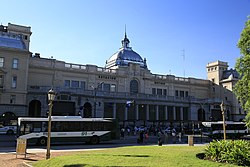Retiro Mitre | |||||
|---|---|---|---|---|---|
| Terminal station | |||||
 Station facade | |||||
| General information | |||||
| Location | Av. Ramos Mejía 1358, Buenos Aires Argentina | ||||
| Coordinates | 34°35′29″S58°22′29″W / 34.59139°S 58.37472°W | ||||
| Owned by | Government of Argentina | ||||
| Operated by | Trenes Argentinos | ||||
| Line(s) | Mitre | ||||
| Platforms | 8 | ||||
| Connections | Subte Retiro Belgrano Retiro San Martín Bus terminus | ||||
| Other information | |||||
| Fare zone | Retiro, Buenos Aires | ||||
| History | |||||
| Opened | August 1, 1915 | ||||
| Designated | 2006 | ||||
| |||||
Retiro-Mitre, or simply Retiro, is one of the six large mainline railway station termini in Buenos Aires, Argentina. Located in the neighborhood of Retiro, it serves as terminal station for the Mitre Line that runs local trains to the northern suburbs of the Buenos Aires metropolitan area. It also functions as terminal station for the national General Mitre Railway, being one of Argentina's largest railway stations..
Contents
Retiro Mitre is accessible by the C line and Line E of the Buenos Aires Metro system and by numerous local public bus services. The station will also be accessible by Line H of the metro once its extension is complete. The station is also near Retiro bus station (Terminal de Omnibus), the principal long-distance bus terminal in Buenos Aires.
In 2006, the station was declared National Historic Monument of Argentina. [1]








